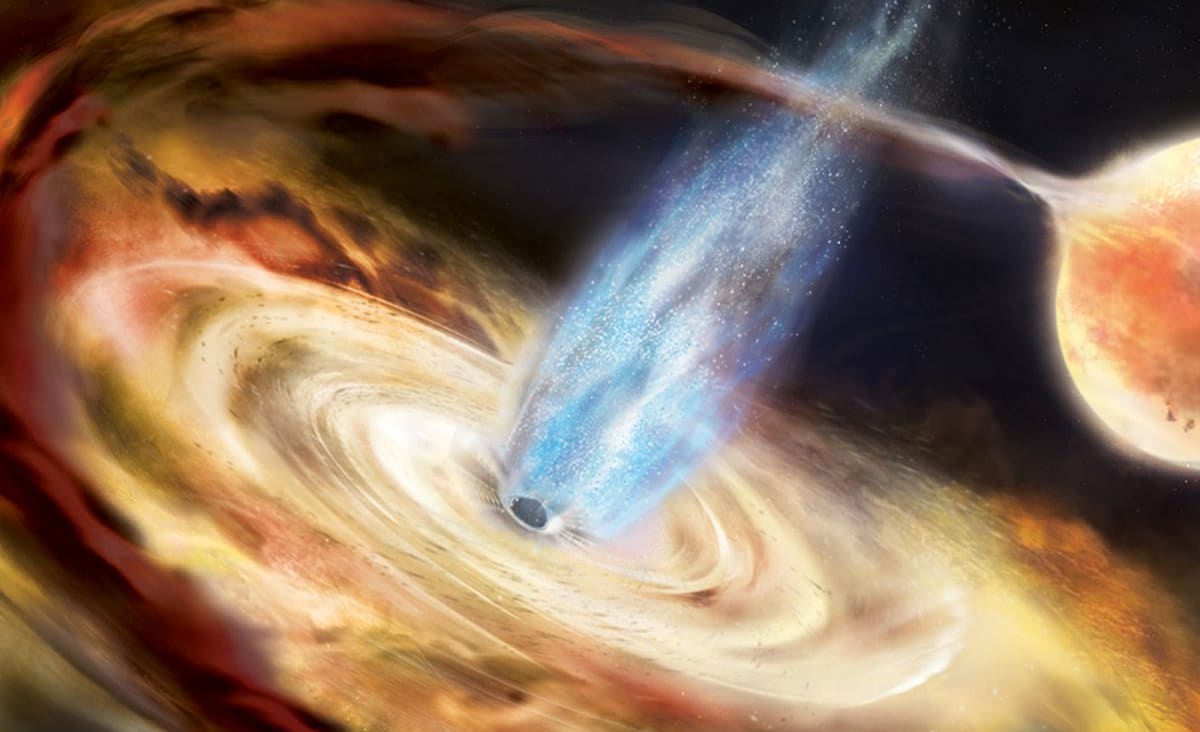
www.space.com
Listen to the 'echoes' of black holes chowing down on stars
A new study identified eight previously unknown echoes from nearby black hole X-ray binary systems in the Milky Way and turned those echoes into sound waves.
Science & Tech
A new study identified eight previously unknown echoes from nearby black hole X-ray binary systems in the Milky Way and turned those echoes into sound waves.
Researchers have detected eight new "echoing" black hole systems in the Milky Way, and they sound like passing through an eerie wind tunnel. And intriguingly, the echoes reveal hints about the role of black holes in galaxy evolution.
The gravitational pull of a black hole is so strong that not even light can escape. Black holes are often surrounded by accumulations of superheated gas and dust known as an accretion disk. When a black hole feeds on this material, it produces bursts of bright X-ray light that bounce and echo off the infalling gas.
In a new study, researchers at the Massachusetts Institute of Technology (MIT) used a tool nicknamed the "Reverberation Machine" to identify eight new echoing black hole binaries, or systems with a star orbiting a black hole. This algorithm analyzes data from NASA's Neutron star Interior Composition Explorer (NICER), a high-time-resolution X-ray telescope aboard the International Space Station.
NICER studies X-ray emissions from sources such as black holes and neutron stars. Using these data, the team's algorithm identified 26 black hole X-ray binaries that were previously known to emit X-ray outbursts. Then, the team narrowed those down to 10 systems that were close and bright enough for the researchers to discern X-ray echoes amid the outbursts.
This method revealed eight previously unknown echoes from nearby black hole X-ray binaries. Before now, only two such systems were known to emit X-ray echoes in the Milky Way, according to a statement from MIT.
Among the eight systems identified, the researchers found that the black holes ranged in mass from five to 15 times the mass of the sun, and all were feeding on sun-like stars. Using these data, the team recreated the evolution of a black hole as it fed on stellar material and then converted the X-ray echoes into sound waves, which you can listen to in the window at the top of the page or directly on YouTube.
https://www.youtube.com/watch?v=iIeIag2Ji8k
Black hole evolution
The researchers compared the echoes across the eight systems, revealing a common evolution in the black holes' immediate vicinity. First, the black holes emit X-rays lasting several weeks, during which time the black holes generate luminous coronas — the regions of high-energy plasma just outside black hole boundaries — and jets of material moving at nearly the speed of light. Then, over several days, the coronas begin to fade and the jets sputter out as the black holes settle into a lower-energy state.
However, the black holes emit one final burst of high-energy particles before disappearing entirely. This could help to explain how supermassive black holes, which are believed to lie at the centers of all large galaxies, eject particles across vast distances and shape galaxy formation, according to the statement.
"The role of black holes in galaxy evolution is an outstanding question in modern astrophysics," Erin Kara, co-author of the study and an assistant professor of physics at MIT, said in the statement. "Interestingly, these black hole binaries appear to be 'mini' supermassive black holes, and so by understanding the outbursts in these small, nearby systems, we can understand how similar outbursts in supermassive black holes affect the galaxies in which they reside."
Some of the X-ray emissions reflect off the black holes' accretion disks, creating echoes of the initial emission. The researchers calculated the distance between a black hole's corona and accretion disk based on when NICER received light from the corona, versus when it detected the X-ray echoes. In turn, the map of the black hole's surroundings revealed hints about how its corona and disk evolved.
In addition, the researchers found that the transitional period from a high- to lower-energy state grew longer in all of the black hole binaries studied, suggesting that the distance between the corona and the disk also grew. This may be the result of the corona briefly expanding during a black hole's last high-energy burst before it finishes its stellar meal and goes quiet, the researchers said in the statement.
"We're at the beginnings of being able to use these light echoes to reconstruct the environments closest to the black hole," Kara said in the statement. "Now we've shown these echoes are commonly observed, and we're able to probe connections between a black hole's disk, jet and corona in a new way."
The findings were published May 2 in The Astrophysical Journal.
























































